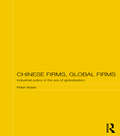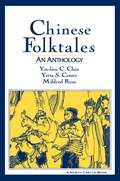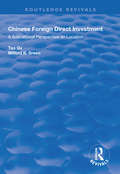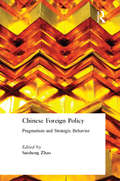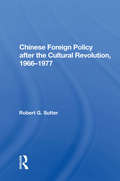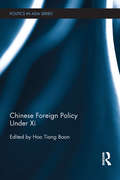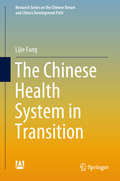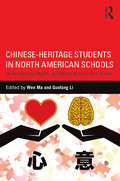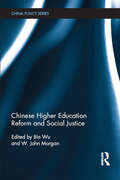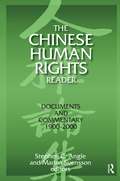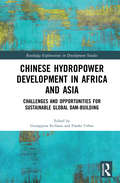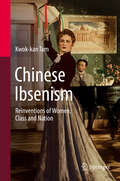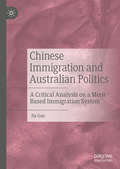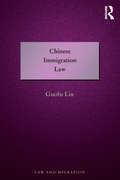- Table View
- List View
Chinese Firms, Global Firms: Industrial Policy in the Age of Globalization (Routledge Studies on the Chinese Economy)
by Peter NolanChina has achieved remarkable, sustained economic growth under the policies of ‘reform and opening up’ put into place since the late 1970s. China’s industrial policies have nurtured a large group of firms with high profits and a high market capitalisation. However, few people in the West can name a single Chinese firm. During the modern era of capitalist globalisation firms from the high income countries have spread their business systems across the world. This has presented a profound challenge for industrial policy in developing countries, including even China, the world’s second largest economy. China is unique among large latecomer developing countries in having reached the position of being a huge, fast-growing economy, with a tremendous impact on the rest of the world, but lacking a substantial group of globally competitive firms. This volume explores this paradox. Fully understanding the industrial policy challenge that the era of capitalist globalisation has produced for China is essential for harmonious international relations.
Chinese Firms, Global Firms: Industrial Policy in the Age of Globalization (Routledge Studies on the Chinese Economy)
by Peter NolanChina has achieved remarkable, sustained economic growth under the policies of ‘reform and opening up’ put into place since the late 1970s. China’s industrial policies have nurtured a large group of firms with high profits and a high market capitalisation. However, few people in the West can name a single Chinese firm. During the modern era of capitalist globalisation firms from the high income countries have spread their business systems across the world. This has presented a profound challenge for industrial policy in developing countries, including even China, the world’s second largest economy. China is unique among large latecomer developing countries in having reached the position of being a huge, fast-growing economy, with a tremendous impact on the rest of the world, but lacking a substantial group of globally competitive firms. This volume explores this paradox. Fully understanding the industrial policy challenge that the era of capitalist globalisation has produced for China is essential for harmonious international relations.
Chinese Folktales: An Anthology
by Yin-Lien C. Chin Yetta S. Center Mildred Ross"Flows with the naturalness of conversation". -- The Small Press Book Review"Translated with simplicity and lucidity". -- The Book Reader"This collection of twelve traditional tales from various parts of China in different time periods represents a popular choice and one sure to be well-received". -- Religious Studies Review
Chinese Folktales: An Anthology
by Yin-Lien C. Chin Yetta S. Center Mildred Ross"Flows with the naturalness of conversation". -- The Small Press Book Review"Translated with simplicity and lucidity". -- The Book Reader"This collection of twelve traditional tales from various parts of China in different time periods represents a popular choice and one sure to be well-received". -- Religious Studies Review
Chinese Foreign Direct Investment: A Subnational Perspective on Location (Routledge Revivals)
by Tao Qu Milford B. GreenFirst published in 1997, this volume emerged in the wake of China’s Open Door policy. Qu and Green focus on the spatial aspects of foreign direct investment within China. They aim to locate FDI within a subnational context, with particular reference to the Chinese experience between 1979 and 1993. Issues explored include the philosophy, objectives and process of inducing FDI, the choice of cities and the country of origin effect. Issues explored include the philosophy, objectives and process of inducing FDI, the choice of cities and the country of origin effect.
Chinese Foreign Direct Investment: A Subnational Perspective on Location (Routledge Revivals)
by Tao Qu Milford B. GreenFirst published in 1997, this volume emerged in the wake of China’s Open Door policy. Qu and Green focus on the spatial aspects of foreign direct investment within China. They aim to locate FDI within a subnational context, with particular reference to the Chinese experience between 1979 and 1993. Issues explored include the philosophy, objectives and process of inducing FDI, the choice of cities and the country of origin effect. Issues explored include the philosophy, objectives and process of inducing FDI, the choice of cities and the country of origin effect.
Chinese Foreign Policy: Pragmatism and Strategic Behavior
by Suisheng ZhaoThis volume explores how China is adapting to international norms and practices while still giving primacy to its national interests. It examines China's strategic behaviour on the world stage, particularly in its relationships with major powers and Asian neighbours.
Chinese Foreign Policy: Pragmatism and Strategic Behavior
by Suisheng ZhaoThis volume explores how China is adapting to international norms and practices while still giving primacy to its national interests. It examines China's strategic behaviour on the world stage, particularly in its relationships with major powers and Asian neighbours.
Chinese Foreign Policy/h
by Robert G. SutterChinese foreign policy has changed radically since the Cultural Revolution of 1966-1969. This book focuses on turning points in China's policy and looks at the influence of foreign pressures on China. It assesses the impact of internal political struggles on the conduct of Chinese foreign affairs.
Chinese Foreign Policy/h
by Robert G. SutterChinese foreign policy has changed radically since the Cultural Revolution of 1966-1969. This book focuses on turning points in China's policy and looks at the influence of foreign pressures on China. It assesses the impact of internal political struggles on the conduct of Chinese foreign affairs.
Chinese Foreign Policy Under Xi (Politics in Asia)
by Hoo Tiang BoonThere has been a discernable calibration of Chinese foreign policy since the ascension of Xi Jinping to the top leadership positions in China. The operative term here is adjustment rather than renovation because there has not been a fundamental transformation of Chinese foreign policy or "setting up of a new kitchen" in foreign affairs. Several continuities in Chinese diplomacy are still evident. The People’s Republic of China (PRC) has not wavered from its overarching strategy of rising through peaceful development. The PRC is still an active participant and leader in, or shaper of, global and regional regimes even as it continues to push for reforms of the extant order, towards an arrangement which it thinks will be less unjust and more equitable. It seeks to better "link up with the international track", perhaps even more so under Xi’s stewardship. Yet amidst these continuities, it is clear that there have been some profound shifts in China’s foreign policy. From the enunciation of strategic slogans such as the "Asian security concept" and "major country diplomacy with Chinese characteristics"; the creation of the China-led and initiated Asian Infrastructure Investment Bank; the pursuit of Xi’s signature foreign policy initiative, the One Belt One Road; to a purportedly more assertive and resolute defense of China’s maritime territorial interests in East Asia—examples of these foreign policy calibrations (both patent and subtle) abound. In short, this has not been a complete metamorphosis but there are real changes, with important repercussions for China and the international system. The burning questions then are What, Where, How and Why: What are these key foreign policy adjustments? Where and how have these occurred in Chinese diplomacy? And what are the reasons or drivers that inform these changes? This book seeks to capture these changes. Featuring contributions from academics, think-tank intellectuals and policy practitioners, all engaged in the compelling business of China-watching, the book aims to shed more light on the calibrations that have animated China’s diplomacy under Xi, a leader who by most accounts is considered the most powerful Chinese numero uno since Deng Xiaoping.
Chinese Foreign Policy Under Xi (Politics in Asia)
by Tiang Boon HooThere has been a discernable calibration of Chinese foreign policy since the ascension of Xi Jinping to the top leadership positions in China. The operative term here is adjustment rather than renovation because there has not been a fundamental transformation of Chinese foreign policy or "setting up of a new kitchen" in foreign affairs. Several continuities in Chinese diplomacy are still evident. The People’s Republic of China (PRC) has not wavered from its overarching strategy of rising through peaceful development. The PRC is still an active participant and leader in, or shaper of, global and regional regimes even as it continues to push for reforms of the extant order, towards an arrangement which it thinks will be less unjust and more equitable. It seeks to better "link up with the international track", perhaps even more so under Xi’s stewardship. Yet amidst these continuities, it is clear that there have been some profound shifts in China’s foreign policy. From the enunciation of strategic slogans such as the "Asian security concept" and "major country diplomacy with Chinese characteristics"; the creation of the China-led and initiated Asian Infrastructure Investment Bank; the pursuit of Xi’s signature foreign policy initiative, the One Belt One Road; to a purportedly more assertive and resolute defense of China’s maritime territorial interests in East Asia—examples of these foreign policy calibrations (both patent and subtle) abound. In short, this has not been a complete metamorphosis but there are real changes, with important repercussions for China and the international system. The burning questions then are What, Where, How and Why: What are these key foreign policy adjustments? Where and how have these occurred in Chinese diplomacy? And what are the reasons or drivers that inform these changes? This book seeks to capture these changes. Featuring contributions from academics, think-tank intellectuals and policy practitioners, all engaged in the compelling business of China-watching, the book aims to shed more light on the calibrations that have animated China’s diplomacy under Xi, a leader who by most accounts is considered the most powerful Chinese numero uno since Deng Xiaoping.
The Chinese Health System in Transition (Research Series on the Chinese Dream and China’s Development Path)
by Lijie FangThis book provides an overview of the ongoing transition in China’s health system, especially focusing on the new healthcare reform initiated in 2009. First, it reviews the changes in China’s healthcare system from the 1950s to 2008, establishing the situation when the reform was introduced. The book subsequently analyzes the social and economic context in which the health system is embedded. Since the primary focus is on the new healthcare reform, the book introduces the blueprint and the year-for-year development of the new healthcare reform, as well as the specific reforms in health financing, public hospitals, and primary care. Given its central importance in the health system, the book also described major trends in long-term care in the past several years. In addition, it examines the health policy-making process with a case study of the New Cooperative Medical Scheme of China. Lastly, the book assesses the performance of China’s health system and predicts future developmental trends.
Chinese-Heritage Students in North American Schools: Understanding Hearts and Minds Beyond Test Scores
by Wen Ma Guofang LiThis comprehensive look at Chinese-heritage students’ academic, sociocultural, and emotional development in the public schools examines pertinent educational theories; complex (even inconvenient) realities; learning practices in and outside of schools; and social, cultural, and linguistic complications in their academic lives across diverse settings, homes, and communities. Chinese-heritage students are by far the largest ethnic group among Asian American and Asian Canadian communities, but it is difficult to sort out their academic performance because NAEP and most state/province databases lump all Asian students’ results together. To better understand why Chinese-heritage learners range from academic role models to problematic students in need of help, it is important to understand their hearts and minds beyond test scores. This book is distinctive in building this understanding by addressing the range of issues related to Chinese-heritage K-12 students’ languages, cultures, identities, academic achievements, and challenges across North American schools.
Chinese-Heritage Students in North American Schools: Understanding Hearts and Minds Beyond Test Scores
by Wen Ma Guofang LiThis comprehensive look at Chinese-heritage students’ academic, sociocultural, and emotional development in the public schools examines pertinent educational theories; complex (even inconvenient) realities; learning practices in and outside of schools; and social, cultural, and linguistic complications in their academic lives across diverse settings, homes, and communities. Chinese-heritage students are by far the largest ethnic group among Asian American and Asian Canadian communities, but it is difficult to sort out their academic performance because NAEP and most state/province databases lump all Asian students’ results together. To better understand why Chinese-heritage learners range from academic role models to problematic students in need of help, it is important to understand their hearts and minds beyond test scores. This book is distinctive in building this understanding by addressing the range of issues related to Chinese-heritage K-12 students’ languages, cultures, identities, academic achievements, and challenges across North American schools.
Chinese Higher Education Reform and Social Justice (China Policy Series)
by John Morgan Bin WuIn place of a distributive justice perspective which focuses simply on equal access to universities, this book presents a broader understanding of the relationship between Chinese higher education and economic and social change. The necessity for research on the place of universities in contemporary Chinese society may be seen from current debates about and policy towards issues of educational inequality at Chinese universities. Many questions arise as a consequence: What are the limitations of neo-liberalism in higher education policy and what are the alternatives? How has the Chinese government met the challenges of educational inequality, and what lessons may be learned from its recent initiatives? How may higher education enhance social justice in Chinese society given economic, social, and cultural inequality? What may be learned from the experience of Macau, Hong Kong, and of Taiwan in terms of achieving social justice in Chinese universities? These questions are considered by a group of leading scholars from both inside and outside China.
Chinese Higher Education Reform and Social Justice (China Policy Series)
by Bin Wu W. John MorganIn place of a distributive justice perspective which focuses simply on equal access to universities, this book presents a broader understanding of the relationship between Chinese higher education and economic and social change. The necessity for research on the place of universities in contemporary Chinese society may be seen from current debates about and policy towards issues of educational inequality at Chinese universities. Many questions arise as a consequence: What are the limitations of neo-liberalism in higher education policy and what are the alternatives? How has the Chinese government met the challenges of educational inequality, and what lessons may be learned from its recent initiatives? How may higher education enhance social justice in Chinese society given economic, social, and cultural inequality? What may be learned from the experience of Macau, Hong Kong, and of Taiwan in terms of achieving social justice in Chinese universities? These questions are considered by a group of leading scholars from both inside and outside China.
The Chinese Human Rights Reader: Documents and Commentary, 1900-2000
by Stephen C. Angle Marina SvenssonRepresentative selections from China's twentieth-century human rights discourse, rendered into fluid and non-technical English. The documents are arranged chronologically, and each is preceded by a brief introduction dealing with the author and the immediate context. The book also includes a glossary in which translations of key terms are linked to their Chinese equivalents.
The Chinese Human Rights Reader: Documents and Commentary, 1900-2000
by Stephen C. Angle Marina SvenssonRepresentative selections from China's twentieth-century human rights discourse, rendered into fluid and non-technical English. The documents are arranged chronologically, and each is preceded by a brief introduction dealing with the author and the immediate context. The book also includes a glossary in which translations of key terms are linked to their Chinese equivalents.
Chinese Hydropower Development in Africa and Asia: Challenges and Opportunities for Sustainable Global Dam-Building (Routledge Explorations in Development Studies)
by Giuseppina Siciliano Frauke UrbanIn recent years, both Chinese overseas investment and hydropower development have been topics of increasing interest and research, with Chinese actors acting as financiers, developers, builders and sub-contractors. Chinese Hydropower Development in Africa and Asia explores the governance and socio-economic implications of large Chinese dams’ development in low- and middle-income countries in Asia and Africa and asks how these big infrastructure projects promote sustainable local and national development in the recipient countries. The book first discusses general aspects of Chinese involvement in hydropower development in Africa and Asia, looking at political and economic aspects, before presenting selected case studies from large dams built and financed by Chinese actors in Asia and Africa. Based on these results, the book further makes recommendations on how to improve the planning, implementation and governance of large dams for sustainable global dam-building. This volume is a valuable resource for academics, researchers and scholars in the areas of Development, Environmental Studies, Politics and Economics.
Chinese Hydropower Development in Africa and Asia: Challenges and Opportunities for Sustainable Global Dam-Building (Routledge Explorations in Development Studies)
by Giuseppina Siciliano Frauke UrbanIn recent years, both Chinese overseas investment and hydropower development have been topics of increasing interest and research, with Chinese actors acting as financiers, developers, builders and sub-contractors. Chinese Hydropower Development in Africa and Asia explores the governance and socio-economic implications of large Chinese dams’ development in low- and middle-income countries in Asia and Africa and asks how these big infrastructure projects promote sustainable local and national development in the recipient countries. The book first discusses general aspects of Chinese involvement in hydropower development in Africa and Asia, looking at political and economic aspects, before presenting selected case studies from large dams built and financed by Chinese actors in Asia and Africa. Based on these results, the book further makes recommendations on how to improve the planning, implementation and governance of large dams for sustainable global dam-building. This volume is a valuable resource for academics, researchers and scholars in the areas of Development, Environmental Studies, Politics and Economics.
Chinese Ibsenism: Reinventions of Women, Class and Nation
by Kwok-kan TamThis book is a study of the relation between theatre art and ideology in the Chinese experimentations with new selfhood as a result of Ibsen’s impact. It also explores Ibsenian notions of self, women and gender in China and provides an illuminating study of Chinese theatre as a public sphere in the dissemination of radical ideas. Ibsen is the major source of modern Chinese selfhood which carries notions of personal and social liberation and has exerted great impacts on Chinese revolutions since the beginning of the twentieth century. Ibsen’s idea of the self as an individual has led to various experimentations in theatre, film and fiction to project new notions of selfhood, in particular women’s selfhood, throughout the history of modern China. Even today, China is experimenting with Ibsen’s notions of gender, power, individualism and self.Kwok-kan Tam is Chair Professor of English and Dean of Humanities and Social Science at the Hang Seng University of Hong Kong. He was Head (2012-18) and is currently a member of the International Ibsen Committee, University of Oslo. He is a Foundation Fellow of the Hong Kong Academy of the Humanities. He has held teaching, research and administrative positions in various institutions, including the East-West Center, the Chinese University of Hong Kong and the Open University of Hong Kong. He has published numerous books and articles on Ibsen, Gao Xingjian, modern drama, Chinese film, postcolonial literature, and world Englishes. His recent books include Ibsen, Power and the Self: Postsocialist Experimentations in Stage Performance and Film (2019), The Englishized Subject: Postcolonial Writings in Hong Kong, Singapore and Malaysia (2019), and a co-edited volume Fate and Prognostication in the Chinese Literary Imagination (2019).
Chinese Immigration and Australian Politics: A Critical Analysis on a Merit-Based Immigration System
by Jia GaoThis book analyses how an increasing number of new Chinese migrants have integrated into Australian society and added a new dimension to Australian domestic politics as a result of Australia’s merit-based immigration system and its shift towards Asia. These policies have helped Australia sustain its growth without a recession for decades, but have also slowly changed established patterns in the distribution of job opportunities, wealth, and political influence in the country. These transformations have recently triggered a strong Sinophobic campaign in Australia, the most disturbing aspect of which is the denial of the successful integration of Chinese migrants into Australian society. Based on evidence gathered through a longitudinal study of Chinese migrants in Australia, this book examines the misconceptions troubling Australia’s current China debate from six important but overlooked perspectives, ranging from migration policy changes, economic factors, grassroots responses, the role of major political parties, community activism, to knowledge issues.
Chinese Immigration Law
by Guofu LiuLacking a single immigration code, Chinese immigration law is widespread, encompassing a variety of laws, regulations and policies, some of which are internal and closed. There is also no immigration cases system. These factors have combined to make the study and understanding of the system difficult for those outside or unfamiliar with this area of Chinese law. To add to this complexity, since the reform and opening-up policy in 1978, Chinese immigration law has been experiencing significant change. In particular, that brought about by the acceptance of a market economy in 1991, and with access to World Trade Organization membership in 2001. Due to the dilation of the legislation, the issue of conflict between Chinese immigration law and other Chinese laws has become serious. This book provides a comprehensive, up-to-date, and readily-accessible reference to Chinese immigration law. It provides the necessary detail, insight and background information for a thorough understanding of this complex system. The book has been written on the basis of Chinese statutes while also including coverage of the relevant international instruments. The work draws on and compares Chinese and English language sources, making it an invaluable resource for both Chinese and non-Chinese readers alike.
Chinese Immigration Law
by Guofu LiuLacking a single immigration code, Chinese immigration law is widespread, encompassing a variety of laws, regulations and policies, some of which are internal and closed. There is also no immigration cases system. These factors have combined to make the study and understanding of the system difficult for those outside or unfamiliar with this area of Chinese law. To add to this complexity, since the reform and opening-up policy in 1978, Chinese immigration law has been experiencing significant change. In particular, that brought about by the acceptance of a market economy in 1991, and with access to World Trade Organization membership in 2001. Due to the dilation of the legislation, the issue of conflict between Chinese immigration law and other Chinese laws has become serious. This book provides a comprehensive, up-to-date, and readily-accessible reference to Chinese immigration law. It provides the necessary detail, insight and background information for a thorough understanding of this complex system. The book has been written on the basis of Chinese statutes while also including coverage of the relevant international instruments. The work draws on and compares Chinese and English language sources, making it an invaluable resource for both Chinese and non-Chinese readers alike.
